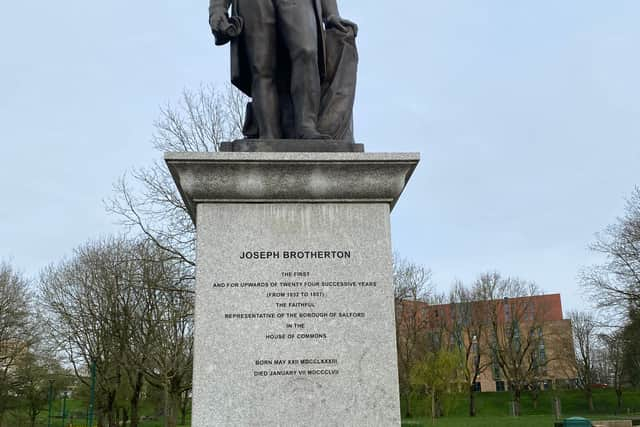Joseph Brotherton: the pioneering Salford MP who helped to shape public parks across Greater Manchester
and live on Freeview channel 276
Salford’s Peel Park is one of the more scenic green spaces around Greater Manchester. Nestled in between the River Irwell and the University of Salford, it is a space that has recently been handed Grade II listed status.
A feature within the park has also been given the title, and it is perhaps the focal point of this park. A statue of Joseph Brotherton, Salford’s first ever MP, stands proud in a park that he helped to create in the 1840s.
Advertisement
Hide AdAdvertisement
Hide AdBrotherton was born in Derbyshire in 1783 and his role in being an active reformer began following the turn of the 19th century. He was a member of a group called the Little Circle, along with other progressives who would go on to be parliamentary campaigners, journalists, MPs and one became Manchester’s first mayor.
One of the group’s main efforts was campaigning for parliamentary reform. This focused on seeing better proportional representation for fast growing industrial towns, including Manchetser and Salford.
Brotherton in Parliament
The aims of the Little Circle were successful when the passing of the Reform Act 1832 took place. An election followed the passing of the act, and it was from this that Brotherton was voted into the constituency. Brotherton was elected in total five times, and for 25 years he was a voice of progression for Salford. He campaigned for the abolition of slavery, was against the death penalty and improvements to free education. Brotherton is also said to have been the first vegetarian Member of Parliament.
Brotherton died suddenly as the result of a heart attack in 1857 when on his way to a meeting in Manchester.
Brotherton and the Parks


Advertisement
Hide AdAdvertisement
Hide AdDuring his time as MP for Salford, Brotherton was involved in campaigns to create municipal parks in industrial areas. The campaigning also led to Manchester and Salford getting democratically elected councils.
In the 1840s Brotherton chaired a committee to create suitable parks in areas, like Manchester and Salford, that had seen populations increase significantly. Peel Park became a place for people to enjoy peaceful surroundings and the beauty of nature at a time when the Industrial Revolution had its grip on the North West.
The travels of the statue
Brotherton’s memory was quickly immortalised and the statue was erected in Peel Park the following year, 1858. Designed by Matthew Noble, the statue stood in the park for almost a century, but in 1954 it was dismantled. In 1969, it was sold into private ownership and the future of the statue looked particularly bleak when it was sold to a scrap metal merchant.
However, knowing the rivalry between Salford and Manchester, the dealer sold the statue to Manchester City Council in 1986. The Brotherton statue was put back on display at Riverside Walk where it remained until 2018 when it was moved back to Peel Park.
